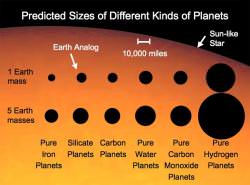Science fiction writers have been imagining other worlds for years, and now they’re going to get a little scientific help, thanks to NASA. The agency recently modeled a range of roughly Earth-sized planets, from the familiar to the exotic. Instead of thinking just about planets with Earthlike characteristics, they imagined every possible kind of planet that might exist around other worlds. This should keep the writers busy.
We’re not talking about familiar looking planets, with strange surface features and aliens with pointed ears here, we’re talking about the very extremes of planetary formation: pure water ice, carbon, iron, silicate, carbon monoxide, and silicon carbide, and others which could be mixtures of these various compounds.
The team eventually came up with 14 different types of solid planets that might exist. “We have learned that extrasolar giant planets often differ tremendously from the worlds in our solar system, so we let our imaginations run wild and tried to cover all the bases with our models of smaller planets,” said NASA’s Marc Kuchner. “We can make educated guesses about where these different kinds of planets might be found. For example, carbon planets and carbon-monoxide planets might favor evolved stars such as white dwarfs and pulsars, or they might form in carbon-rich disks like the one around the star Beta Pictoris. But ultimately, we need observations to give us the answers.”
They calculated how gravity should compress planets of varying composition. For example, a pure water planet would be about the same size as the Earth, while an iron planet would be a third our size.
The researchers are hoping their calculations will help future planet hunters identify new discoveries. When powerful planet finders, such as ESA’s Corot mission start making discoveries, astronomers will be working hard to categorize what they’re looking at, based only on the mass and size. Even more powerful observatories, such as the James Webb Space Telescope will let astronomers actually measure the chemical constituents of a planet, and help reveal if we’re looking at a sphere of carbon or water ice.
Their paper will appear in the October 20th issue of the Astrophysical journal.
Original Source: NASA News Release

